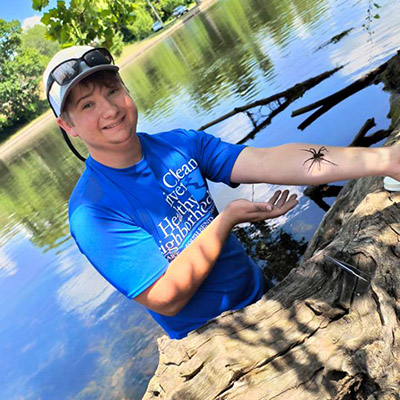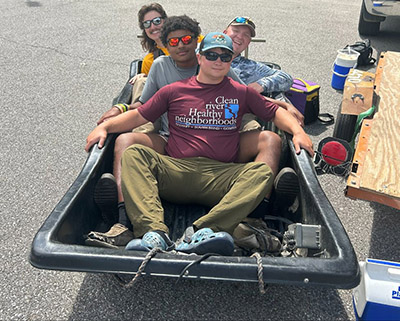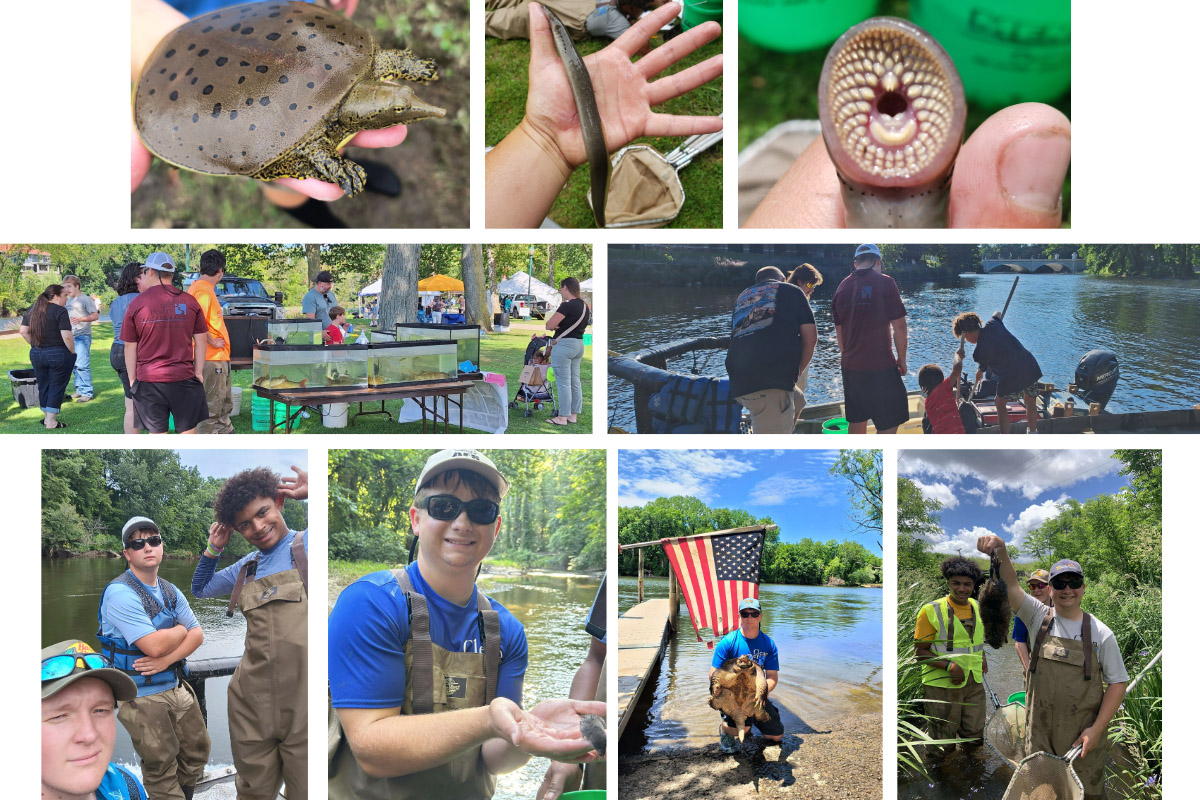FNR Field Report: Noah Haas
Students from Purdue Forestry and Natural Resources took their classroom knowledge to the field for summer internships and paid positions across the country, gaining valuable experience, hands-on training and career guidance. The FNR Field Reports series offers updates from those individuals as positions draw to a close.
Noah Haas, a junior majoring in aquatic sciences – fisheries, worked as a crew leader for an aquatic survey team on the St. Joseph River Watershed. In this position, Haas and his team conducted electrofishing surveys on the St. Joseph River and its tributaries, which involved driving the electrofishing boat, tagging fish, equipment maintenance and more.
This summer marked the third year Haas has worked for the cities of Elkhart and South Bend in their joint Aquatic Monitoring Program. His first year he acted as a field technician, and for the past two years he has acted as a crew leader.
“I first met my current boss, Daragh Deegan (water quality manager for the City of Elkhart) at an event at the school where my mother teaches when I was about five or six,” Haas explained. “I was already fascinated with fish, and I knew the moment I heard about the program that it was what I wanted to do in life. So, I spent my childhood volunteering at any event Daragh would have me around for until I was old enough to get hired. After spending a season learning the ropes, Daragh appointed a good friend and I as the crew leaders for the next two seasons. Daragh took a different position the following year, which meant he couldn’t be in the field much. It was up to Leo and I to keep things moving smoothly with the crew, doing dozens of barge and backpack sites on our own. We even did a few boat sites on our own, which involved me driving the boat.”
Haas and his team’s tasks included collecting fish with various types of electrofishing equipment, measuring and counting them, as well as tagging them. They also organized events where they taught children at parks, schools and large community events about their local river and the fish that call it home.
The Osceola, Indiana, native, said his favorite part of the job is that his team consists of himself and four of his best friends.
“I get to spend all day with the animals I love while making jokes and memories with some awesome guys,” he said. “I also really like catching snapping turtles. They are just really funny to me; they just seem permanently mad at the world and are very stubborn. Our program also collects turtle data, so we scoop up snapping turtles while we go.”
The job isn’t all fun as it includes a lot of manual labor. Haas and his team carried hundreds of pounds of equipment from site to site -- things like a generator, a five-gallon bucket full of bricks and buckets of water -- down rocky banks, up hills and through log jams.
Haas also noted that what can be hard about the job is that things rarely go as planned in the field, whether it's electrical issues or that you just forgot a vital piece of equipment. “It can all be rather frustrating or disheartening,” he noted.
In addition to utilizing the skills he has built up over the last two years with the Aquatic Monitoring Program, Haas has been able to test out of some of the things he learned in his FNR classes.
“I was able to incorporate some techniques that I learned at Purdue into our work,” Haas said. “Namely, we decided to use a seine when trying to target banded killifish specifically because for some reason they seem almost immune to electrofishing.”
almost immune to electrofishing.”
Haas said that his experience this summer hasn't changed what he thought my career path would be, but it "has reaffirmed that I am doing and chasing what I love to do.”
In addition to his summer work experience, Haas is involved with the Purdue chapter of the American Fisheries Society, acting as its 2023-24 and 2024-25 president. He also is an avid member of the Bass Fishing Club and has fished at national events on Kentucky Lake and the Lake of the Ozarks.
Haas is working on an independent research project under Dr. Tomas Höök, looking at the expansion of the banded killifish subspecies. He also has worked as a lab technician in Höök’s lab for the past two years.
 A collage of images from Noah Haas' summer on the St. Joseph Watershed. Top row (Left to Right): A spiny softshell turtle; a chestnut lamprey; a close up of the mouth of a very large chestnut lamprey. Row 2: A presentation at a local event where Haas and his colleagues educated the public about the river; children release fish from the live wells of a boat after a demonstration. Row 3: Noah with colleagues on the way to an electrofishing expedition; Noah holds a short-tailed shrew the team saved while it was crossing the stream; Noah holds a snapping turtle in front of an American flag he found in the river; Noah holds a muskrat that was found in a creek. (All animals were caught and handled with proper permits.)
A collage of images from Noah Haas' summer on the St. Joseph Watershed. Top row (Left to Right): A spiny softshell turtle; a chestnut lamprey; a close up of the mouth of a very large chestnut lamprey. Row 2: A presentation at a local event where Haas and his colleagues educated the public about the river; children release fish from the live wells of a boat after a demonstration. Row 3: Noah with colleagues on the way to an electrofishing expedition; Noah holds a short-tailed shrew the team saved while it was crossing the stream; Noah holds a snapping turtle in front of an American flag he found in the river; Noah holds a muskrat that was found in a creek. (All animals were caught and handled with proper permits.) 





